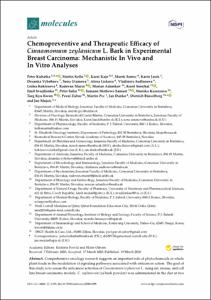Chemopreventive and Therapeutic Efficacy of Cinnamomum zeylanicum L. Bark in Experimental Breast Carcinoma: Mechanistic In Vivo and In Vitro Analyses
- Affiliated Author(s)
- 권택규
- Alternative Author(s)
- Kwon, Taeg Kyu
- Journal Title
- Molecules (Basel, Switzerland)
- ISSN
- 1420-3049
- Issued Date
- 2020
- Keyword
- apoptosis; cancer stem cells; cell proliferation; Cinnamomum zeylanicum; epigenetics; mammary carcinogenesis; MCF-7 cells; MDA-MB-231 cells; mouse; preventive medicine; rat
- Abstract
- Comprehensive oncology research suggests an important role of phytochemicals or whole plant foods in the modulation of signaling pathways associated with anticancer action. The goal of this study is to assess the anticancer activities of Cinnamomum zeylanicum L. using rat, mouse, and cell line breast carcinoma models. C. zeylanicum (as bark powder) was administered in the diet at two concentrations of 0.1% (w/w) and 1% (w/w) during the whole experiment in chemically induced rat mammary carcinomas and a syngeneic 4T1 mouse model. After autopsy, histopathological and molecular evaluations of mammary gland tumors in rodents were carried out. Moreover, in vitro analyses using MCF-7 and MDA-MB-231 cells were performed. The dominant metabolites present in the tested C. zeylanicum essential oil (with relative content over 1%) were cinnamaldehyde, cinnamaldehyde dimethyl acetal, cinnamyl acetate, eugenol, linalool, eucalyptol, limonene, o-cymol, and α-terpineol. The natural mixture of mentioned molecules demonstrated significant anticancer effects in our study. In the mouse model, C. zeylanicum at a higher dose (1%) significantly decreased tumor volume by 44% when compared to controls. In addition, treated tumors showed a significant dose-dependent decrease in mitotic activity index by 29% (0.1%) and 45.5% (1%) in comparison with the control group. In rats, C. zeylanicum in both doses significantly reduced the tumor incidence by 15.5% and non-significantly suppressed tumor frequency by more than 30% when compared to controls. An evaluation of the mechanism of anticancer action using valid oncological markers showed several positive changes after treatment with C. zeylanicum. Histopathological analysis of treated rat tumor specimens showed a significant decrease in the ratio of high-/low-grade carcinomas compared to controls. In treated rat carcinomas, we found caspase-3 and Bax expression increase. On the other hand, we observed a decrease in Bcl-2, Ki67, VEGF, and CD24 expressions and MDA levels. Assessment of epigenetic changes in rat tumor cells in vivo showed a significant decrease in lysine methylation status of H3K4m3 and H3K9m3 in the high-dose treated group, a dose-dependent increase in H4K16ac levels (H4K20m3 was not changed), down-regulations of miR21 and miR155 in low-dose cinnamon groups (miR22 and miR34a were not modulated), and significant reduction of the methylation status of two out of five gene promoters-ATM and TIMP3 (PITX2, RASSF1, PTEN promoters were not changed). In vitro study confirmed results of animal studies, in that the essential oil of C. zeylanicum displayed significant anticancer efficacy in MCF-7 and MDA-MB-231 cells (using MTS, BrdU, cell cycle, annexin V/PI, caspase-3/7, Bcl-2, PARP, and mitochondrial membrane potential analyses). As a conclusion, C. zeylanicum L. showed chemopreventive and therapeutic activities in animal breast carcinoma models that were also significantly confirmed by mechanistic evaluations in vitro and in vivo.
- Department
- Dept. of Immunology (면역학)
- Publisher
- School of Medicine (의과대학)
- Citation
- Peter Kubatka et al. (2020). Chemopreventive and Therapeutic Efficacy of Cinnamomum zeylanicum L. Bark in Experimental Breast Carcinoma: Mechanistic In Vivo and In Vitro Analyses. Molecules (Basel, Switzerland), 25(6), 1399. doi: 10.3390/molecules25061399
- Type
- Article
- ISSN
- 1420-3049
- Appears in Collections:
- 1. School of Medicine (의과대학) > Dept. of Immunology (면역학)
- 파일 목록
-
-
Download
 oak-2020-0499.pdf
기타 데이터 / 9.2 MB / Adobe PDF
oak-2020-0499.pdf
기타 데이터 / 9.2 MB / Adobe PDF
-
Items in Repository are protected by copyright, with all rights reserved, unless otherwise indicated.